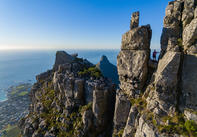The Cape Rocks
The Cape rocks are believed to have been laid down mainly as marine deposits. Initially, the ocean lay far beyond the present line of the continent, but as the waters encroached northward they deposited a spine of Table Mountain Sandstone along what became the southern rim of Africa.

On top of the Table Mountain Group were laid sandstones and shales of the Bokkeveld Group, which are rich in shallow marine fossils including trilobites and brachiopods. Towards the end of the deposition cycle, these were replaced by plant fossils.
Finally, the Witteberg Group was also laid down under oceanic conditions and a number of early ray-finned fish fossils are the most significant finds, although ten genera and 16 species of vascular plant have also been described from the Witteberg rocks.
The awe-inspiring natural beauty of Table Mountain National Park should make it the place to visit and the top of your Western Cape to-do list. As well as the mountain, Boulders and its famous penguin colony lie within its borders, as does Cape Point. It's a park where mountains drop dramatically.
On top of the Table Mountain Group were laid sandstones and shales of the Bokkeveld Group, which are rich in shallow marine fossils including trilobites and brachiopods.
Towards the end of the deposition cycle, these were replaced by plant fossils. Finally, the Witteberg Group was also laid down under oceanic conditions and a number of early ray-finned fish fossils are the most significant finds, although ten genera and 16 species of vascular plant have also been described from the Witteberg rocks.
The awe-inspiring natural beauty of Table Mountain National Park should make it the place to visit and the top of your Western Cape to-do list. As well as the mountain, Boulders and its famous penguin colony lie within its borders, as does Cape Point. It's a park where mountains drop dramatically.
Classic Rock Routes

The first recorded ascent of Table Mountain was in 1503 by the Portuguese admiral, Antonio da Saldanha, while en route to the East. The Dutch colonists who first settled here appear to have spent precious little time on this sort of recreation, for their aim was the far more serious business of commerce, agriculture and trade.
With the British occupation of the Cape, however, it soon became a popular pastime to scale the great Table from town, by way of Platteklip's beckoning gorge. The fashion really took hold after Lady Anne Barnard, the colony's most chronicled socialite, took a picnic on top of the mountain, with the great baskets being carried up by slaves.
In the 1700s, three famous European naturalists, Carl Thunberg, Anders Sparrman and Francois le Vaillant enjoyed trips up Table Mountain. Le Vaillant managed to negotiate a five-day traverse along the peninsula's mountain spine - a walk that is commemorated in this volume.
Jan van Hunks

In the 18th century, a Dutch pirate, Jan van Hunks, retired to the far-flung colony of the Cape, thinking he would be beyond the reach of both his reputation and the law. He loved to stroll along the paths of lower Table Mountain and its two flanking hills, climbing to Breakfast Rock on the saddle between Table Mountain and its sharp-peaked neighbour, where he would smoke his pipe in the afternoons.
But one day, at his favourite seat, he found a cloaked stranger, who challenged him to a smoking contest. What followed was the greatest duel of its kind ever recorded. Who won is not known, but for his sins Van Hunks was sentenced to relive the duel for eternity. What is known is that that is how Devil's Peak got its name, and how Table Mountain got its cloth.